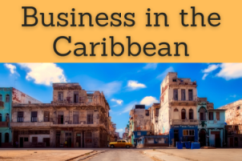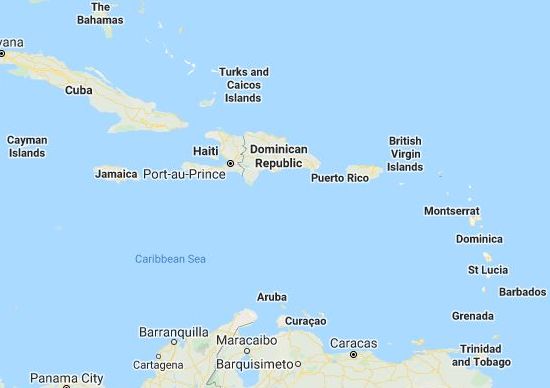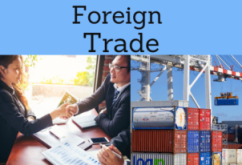Business in Saint Vincent and the Grenadines

Foreign Trade and Business in Saint Vincent and the Grenadines - Kingstown. Saint Vincentian Economy
- Introduction to Saint Vincent and the Grenadines
- Business in Kingstown
- Saint Vincentian Economy
- Saint Vincentian Foreign Trade
- Business Opportunities in Saint Vincent and the Grenadines
- Access to the Saint Vincentian Market
- Business Plan for Saint Vincent and the Grenadines
The objectives of the subject «Doing Business in Saint Vincent and the Grenadines» are the following:
- To analyze the Saint Vincentian Economy and Global Trade
- To explore the Business Opportunities in Saint Vincent and the Grenadines
- To analyze the trade relations of Saint Vincent and the Grenadines with the country of the student
- To know the Trade Agreements of Saint Vincent and the Grenadines
- To develop a business plan for the Saint Vincentian Market

The Subject «Foreign Trade and Business in Saint Vincent and the Grenadines» belongs to the following Online Programs taught by EENI Global Business School:
Masters: International Business, Foreign Trade.
Languages  (
( San Vicente y las Granadinas
San Vicente y las Granadinas
 Saint-Vincent-et-les-Grenadines
Saint-Vincent-et-les-Grenadines  São Vicente e Granadinas).
São Vicente e Granadinas).

Masters adapted for Caribbean students.
International Trade and Business in Saint Vincent and the Grenadines:

Preferential Access and Trade Agreements of Saint Vincent and the Grenadines:
- Saint Vincent and the Grenadines and the Caribbean Economic Area
- CARICOM
- CARICOM-Dominican Republic Agreement
- Costa Rica-CARICOM Agreement (Saint Vincent and the Grenadines)
- CARIFORUM-EU Agreement
- Colombia-CARICOM Agreement (Saint Vincent and the Grenadines)
- UK-CARIFORUM Free Trade and Economic Integration Agreement
- Association of Caribbean States
- Caribbean Basin Initiative
- The U.S.-Caribbean Basin Trade Partnership Act
- Caribbean-Canada Trade Agreement
- Organization of Eastern Caribbean States
- ALBA
- Energy supply agreement with Venezuela (PetroCaribbean)

- WTO
- GATS
- Agreement on the Application of Sanitary Measures
- Agreement on Technical Barriers to Trade
- Agreement on Preshipment Inspection
- Agreement on Safeguards
- Trade Facilitation Agreement
- BIC (Containers)
- Chicago Convention (ICAO)
- International Maritime Organization
- Hamburg Rules
- Is not a member of the WCO

- OAS
- CELAC
- EU-CELAC Summit
- ECLAC

- WTO
- IMF
- UN
- UNCTAD
- ITC
- WIPO
- WB
- Commonwealth
- ...
- Saint Vincent and the Grenadines is made up of:
- The island of Saint Vincent
- The Grenadines Archipelago (66% of the northern part)
- Saint Vincentian capital: Kingstown (island of San Vicente)
- Parishes of Saint Vincent and the Grenadines: Charlotte, Saint Andrew, Saint David, Saint George, Saint Patrick and the Grenadines
- Saint Vincent and the Grenadines does not share land borders with any country
- Nearest countries to Saint Vincent and the Grenadines by sea: Grenada, Saint Lucia and Venezuela
- Area of Saint Vincent and the Grenadines: 387 km²
- Population of Saint Vincent and the Grenadines: 110,000 inhabitants;
- Saint Vincentian Population density: 283 inhabitants / km²
- 66% of the population has an African origin
- Official language of Saint Vincent and the Grenadines: English (Vincentian Creole)
- Abolition of Slavery in Saint Vincent and the Grenadines: 1834
- Climate of Saint Vincent and the Grenadines: tropical
- 1498: discovery by the Spanish (Grenadines derivates from the city of Granada, Spain)
- 1719: French colonization
- 1779: British colonization
- Type of government: Unitary parliamentary constitutional monarchy (Queen Elizabeth II, Commonwealth)
- Saint Vincent and the Grenadines became independent from the UK in 1979
Main religion in Saint Vincent and the Grenadines: Christianity (Protestantism).

Saint Vincent and the Grenadines belongs to the Caribbean Economic Area.

Saint Vincentian Economy.
- High risk of natural disasters (tropical storms)
- Saint Vincentian GDP (PPP): 1,243 million dollars
- GDP per capita of Saint Vincent and the Grenadines (PPP): 11,291 Dollars
- World Bank Classification: Lower Middle Income Economy
- Agriculture is the main economic activity of Saint Vincent and the Grenadines
- Important export of bananas (50% of exports)
- World leading producer of arrowroot
- Tourism is an emerging sector
- Construction boom and off-shore banking
- Main industries: food processing, furniture manufacturing, textiles, cement production and starch production
- Currency Saint Vincentian: East Caribbean dollar (XCD)
- Country code top-level domain of Saint Vincent and the Grenadines: .vc
- Argyle International Airport
- It drives on the left

Saint Vincentian Foreign Trade
- Main Exports of Saint Vincent and the Grenadines are bananas, maranta, tennis rackets
- Main export markets of Saint Vincent and the Grenadines: the U.S., the UK, France, Italy, Greece, China, India, Poland, Trinidad and Tobago, Saint Lucia, Barbados, Dominica, Grenada, Antigua and Barbuda
- Main imports of Saint Vincent and the Grenadines: food, machinery, chemicals, fertilizers, minerals and fuels
- Largest providers of Saint Vincent and the Grenadines: the U.S., Trinidad and Tobago, Singapore, the UK, countries of the CARICOM, China, Italy, Turkey, France, Romania
(c) EENI Global Business School (1995-2024)
We do not use cookies
Top of this page



